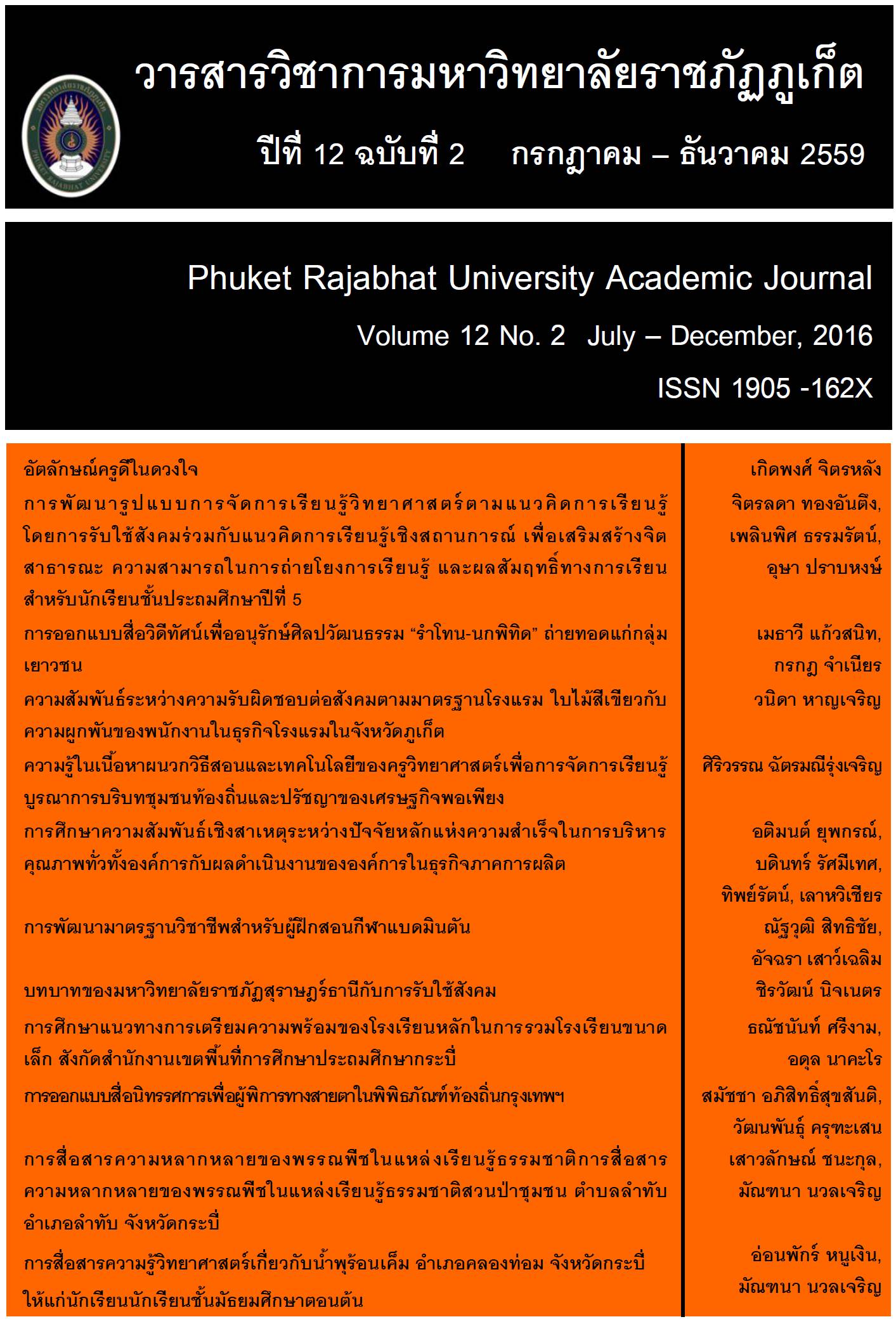การศึกษาความสัมพันธ์เชิงสาเหตุระหว่างปัจจัยหลักแห่งความสำเร็จ ในการบริหารคุณภาพทั่วทั้งองค์การกับผลดำเนินงานขององค์การ ในธุรกิจภาคการผลิต
Main Article Content
บทคัดย่อ
แม้ว่าแนวคิดด้านการบริหารคุณภาพทั่วทั้งองค์การจะได้รับความสนใจเป็นวงกว้างในการนำมาใช้เพื่อสร้างความสามารถในการแข่งขันได้ให้กับองค์การ แต่กลับพบว่ามีองค์การจำนวนมากที่ประสบปัญหาในการนำแนวคิดดังกล่าวไปปฏิบัติ โดยเฉพาะในเรื่องการกำหนดและจัดลำดับความสำคัญของการดำเนินงานในองค์การ การวิจัยนี้มีวัตถุประสงค์เพื่อศึกษาการบริหารคุณภาพทั่วทั้งองค์การของบริษัทในภาคการผลิตที่ได้รับการรับรองมาตรฐานไอเอสโอ 9001 โดย 1) ศึกษาความสัมพันธ์เชิงสาเหตุระหว่างปัจจัยหลักแห่งความสำเร็จทั้งหกด้านของการบริหารคุณภาพทั่วทั้งองค์การซึ่งใช้กรอบแนวคิดของเกณฑ์รางวัลคุณภาพแห่งชาติทั้งหกหมวด และ 2) ศึกษาความสัมพันธ์เชิงสาเหตุระหว่างปัจจัยหลักแห่งความสำเร็จดังกล่าวกับผลการดำเนินงานขององค์การ
กลุ่มตัวอย่างที่ใช้ในงานวิจัยประกอบด้วยองค์การในภาคการผลิตในประเทศไทยที่ได้รับการรับรองมาตรฐานไอเอสโอ 9001 และลงทะเบียนไว้กับสำนักงานมาตรฐานผลิตภัณฑ์อุตสาหกรรมจำนวน 155 องค์การ โดยใช้แบบสอบถามออนไลน์ในการเก็บรวบรวมข้อมูลจากผู้ตอบแบบสอบถามซึ่งเป็นผู้บริหารหรือผู้แทนองค์การ ในช่วงเดือนกันยายนถึงเดือนธันวาคม 2558 และวิเคราะห์ผลโดยโปรแกรมสำเร็จรูปทางสถิติ ด้วยเทคนิคการวิเคราะห์พหุตัวแปร โดยการวิเคราะห์องค์ประกอบเชิงยืนยัน และการวิเคราะห์โมเดลสมการโครงสร้าง เพื่อหาความสัมพันธ์เชิงสาเหตุของตัวแปรแฝงด้านการนำองค์การ การวางแผนกลยุทธ์ การมุ่งเน้นลูกค้า การวัดและวิเคราะห์ผล การมุ่งเน้นบุคลากร การมุ่งเน้นด้านการปฏิบัติการ และผลการดำเนินงานขององค์การ
ผลการวิจัยพบว่า 1) พบความสัมพันธ์เชิงสาเหตุจำนวน 9 ความสัมพันธ์ ได้แก่ การนำองค์การมีความสัมพันธ์เชิงสาเหตุกับการวางแผนกลยุทธ์ การมุ่งเน้นลูกค้า และการมุ่งเน้นบุคลากร การวางแผนเชิงกลยุทธ์มีความสัมพันธ์เชิงสาเหตุกับการวัดและวิเคราะห์ผล และการมุ่งเน้นบุคลากร การมุ่งเน้นลูกค้ามีความสัมพันธ์เชิงสาเหตุกับการมุ่งเน้นการปฏิบัติการ การวัดและวิเคราะห์ผลมีความสัมพันธ์เชิงสาเหตุกับการมุ่งเน้นการปฏิบัติการ การมุ่งเน้นบุคลากรมีความสัมพันธ์เชิงสาเหตุกับการมุ่งเน้นลูกค้า และการวัดและวิเคราะห์ผล 2) พบความสัมพันธ์เชิงสาเหตุระหว่างการมุ่งเน้นการปฏิบัติการกับผลการดำเนินงานขององค์การ จากผลการวิจัยดังกล่าวจึงมีข้อเสนอแนะให้องค์การในภาคการผลิตให้ความสำคัญกับการกำหนดมาตรฐานการดำเนินงานในแต่ละกระบวนการที่สำคัญ โดยนอกจากกระบวนการผลิตแล้วองค์การควรให้ความสำคัญต่อกระบวนการที่เกี่ยวข้องตลอดห่วงโซ่อุปทาน รวมทั้งควรนำเครื่องมือด้านคุณภาพและการใช้ข้อมูลทางสถิติมาช่วยในการติดตามการปฏิบัติการและผลดำเนินงานอย่างสม่ำเสมอ โดยผู้นำองค์การมีบทบาทสำคัญเป็นแกนหลักในการขับเคลื่อนและติดตามการดำเนินงานด้านต่างๆ เพื่อให้เกิดการปรับปรุงอย่างต่อเนื่อง
Article Details
เนื้อหาและข้อมูลในบทความที่ลงตีพิมพ์ในวารสารวิชาการมหาวิทยาลัยราชภัฏภูเก็ต ถือเป็นข้อคิดเห็นและความรับผิดชอบของผู้เขียนบทความโดยตรง ซึ่งกองบรรณาธิการวารสารฯ ไม่จำเป็นต้องเห็นด้วยหรือร่วมรับผิดชอบใด ๆ
บทความ ข้อมูล เนื้อหา รูปภาพ ฯลฯ ที่ได้รับการตีพิมพ์ในวารสารวิชาการมหาวิทยาลัยราชภัฏภูเก็ต ถือเป็นลิขสิทธิ์ของวารสารวิชาการมหาวิทยาลัยราชภัฏภูเก็ต หากบุคคลหรือหน่วยงานใดต้องการนำทั้งหมดหรือส่วนหนึ่งส่วนใดไปเผยแพร่ต่อหรือเพื่อกระทำการใด ๆ จะต้องได้รับอนุญาตเป็นลายลักษณ์อักษรจากวารสารวิชาการมหาวิทยาลัยราชภัฏภูเก็ตก่อนเท่านั้น
เอกสารอ้างอิง
Anderson, J. C., Rungtusanatham, M., Schroeder, R. G.. 1994. A theory of quality management underlying the Deming management method. Academy of Management. The Academy of Management Review. 19(3) : 472-509.
__________., Rungtusanatham, M., Schroeder, R. G., & Devaraj, S. 1995. A path analytic model of a theory of quality management underlying the Deming management method: preliminary empirical findings. Decision Sciences. 26(5) : 637-658.
Baird, K., Hu, K. J., & Reeve, R. (2011). The relationships between organizational culture, total quality management practices and operational performance. International Journal of Operations & Production Management. 31(7) : 789–814.
Black, S. & Porter, L. J. (1995). An empirical model for total quality management. Total Quality Management. 6(2) : 149-164.
Dale, B. G. (2003). Managing Quality. Fourth edition. Blackwell Publishing: Massachusetts.
Das, A., Paul, H., & Swierczek, F. W. (2008). Developing and validating total quality management (TQM) constructs in the context of Thailand's manufacturing industry. Benchmarking. 15(1) : 52-72.
Dean, J. W. & Bowen, D. E. (1994). Management theory and total quality: improving research and practice through theory development. The Academy of Management Journal. 19(3) : 392-418.
Dow, D., Samson, D. & Ford, S. (1999). Exploding the myth: Do all quality management practices contribute to superior quality performance? Production and Operations Management. 8(1) : 1-27.
Flynn, B., Schroeder, R. G. & Sakakibara, S. (1994). A framework for quality management research and an associated measurement instrument. Journal of Operations Management. 11(4) : 339-366.
__________., Schroeder, R. G. & Sakakibara, S. (1995). The impact of quality management practices on performance and competitive advantage. Decision Science. 26(5) : 659-691.
Fotopoulos, C. B. & Psomas, E. L. (2009). The impact of "soft" and "hard" TQM elements on quality management results. The International Journal of Quality & Reliability Management. 26(2) : 150-163.
Hair, J. F. Jr., Black, W. C., Babin, B. J. & Anderson, R. E. (2014). Multivariate Data Analysis. 7th ed. New Jersey : Pearson Education Limited.
Kaynak, H. (2003). The relationship between total quality management practices and their effects on firm performance. Journal of Operations Management. 21(4) : 405-435.
Kelley, K. (2005). The effects of nonnormal distributions on confidence intervals around the standardized mean difference: bootstrap and parametric confidence intervals. Educational and Psychological Measurement. 65(1) : 51-69
Krasachol, L. (1999). The Development of Quality Management in Thailand. Doctor of Philosophy, University of Nottingham.
Lee, S. M., Rho, B.-H. & Lee, S.-G. (2003). Impact of Malcolm Baldrige national quality award criteria on organizational quality performance. International Journal of Production Research. 41(9) : 2003-2020.
National Institute of Standards and Technology [NIST]. (2013). 2013–2014 Criteria for Performance Excellence. United States Department of Commerce. Gaithersburg.
Powell, T.C. (1995). Total quality management as competitive advantage: a review and empirical study. Strategic Management Journal. 16(1) : 15-37.
Prajogo, D. I. & Brown, A. (2004). The relationship between TQM practices and quality performance and the role of formal TQM programs: An Australian empirical study. The Quality Management Journal. 11(4) : 31-42.
. & Sohal, A. S. (2006). The integration of TQM and technology / R&D management in determining quality and innovation performance. Omega 34(3) : 296–312.
Salaheldin, S. I. (2009). Critical success factors for TQM implementation and their impact on performance of SMEs. International Journal of Productivity and Performance Management. 58(3) : 215-237.
Samson, D. & Terziovski, M. (1999). The relationship between total quality management practices and operational performance. Journal of Operations Management. 17(4) : 393-409.
Sila, I. & Ebrahimpour, M. (2003). Examination and comparison of the critical factors of total quality management (TQM) across countries. International Journal of Production Research. 41(2) : 235-268.
Siriprapawan, N. & Walsh, J. (2008). Evaluation of the Thailand Quality Award for small and medium sized enterprises. [On-line]. Available : http://dspace.siu.ac.th/bitstream/1532/226/1/SIUPSSOM-MBA-2007-02.pdf [2012, November 8].
Tamimi, N. & Sebastianelli, R. (1998). The barriers of TQM. Quality Progress. 31(6) : 57-60.
Tari, J. J., Molina, J. F., & Castejon, J. L. (2007). The relationship between quality management practices and their effects on quality outcomes. European Journal of Operational Research. 183(2) : 483–501.
Taylor, W. A. & Wright ,G. H. (2003). A longitudinal study of TQM implementation: factors influencing success and failure. Omega 31(2) : 97-111.
Venugopal, K. R. & Patnaik, L. M. (2011). Computer Networks and Intelligent Computing: 5th International Conference on Information Processing, ICIP 2011, Bangalore, India, August 5-7, 2011. Proceedings. India : Springer.


